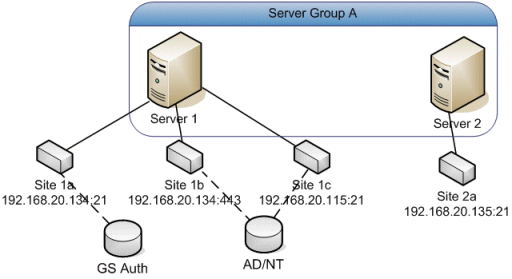How EFT Sites are Defined
In EFT hierarchy, Server Groups are at the top of EFT's setting hierarchy and allow you to group multiple Servers from a management or administrative perspective. A Server consists of one or more physical hardware devices or virtual servers running the EFT executable as a system service. Each EFT service can support multiple Sites. A Site in EFT is similar to a virtual FTP server bound to one or more IP addresses.
You cannot run multiple Sites on the same IP address and port. Each Site requires an IP address and port combination that is not already claimed by other process or Site. To avoid conflicts, when the same protocol is used, each Site requires a distinct IP address (and same port), or the same IP address, but different ports. For example, use port 8080 for HTTP instead of 80, or 2121 for FTP instead of 21. You cannot have two Sites trying to use port 21 on the same IP address. The two Sites will conflict; the Site that starts first claims the contested port.
The hardware in EFT's computer does not limit the number of Sites you can set up, at least regarding how many NICs (Network Interface Cards) you have. In Windows, you can assign any number of IP addresses to a single NIC.

In the above example, your internal users could connect to site 1A using the Site's internal IP address (192.168.20.134:21) while external users can access site 1C using the host address you designate, such as partners.globalscape.com, which resolves to a different IP address on the same port).
Sites can each have a unique authentication provider type, the same authentication provider type, or even share the same authentication provider database. For example, Site 1A could use Globalscape Authentication, Site 1B could use Active Directory (AD), and Site 1C could share the AD database.
The EFT service runs under a user account, which must have full administrative rights to the folder in which you installed EFT. With administrative rights, the EFT service can save all your settings. If the EFT service does not have administrative rights, you lose settings and user accounts whenever you restart the EFT service, and you need to reset permissions on the computer where the EFT service is running.
You will need the following information to create and configure a Site: